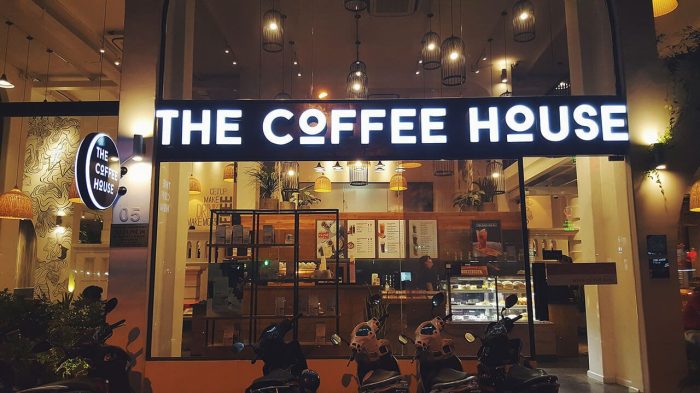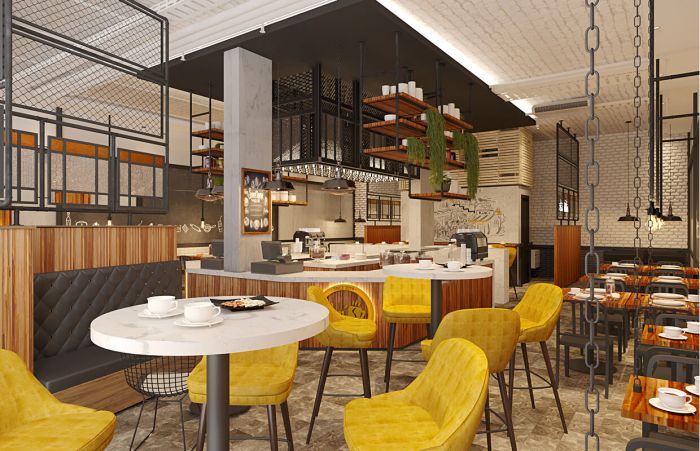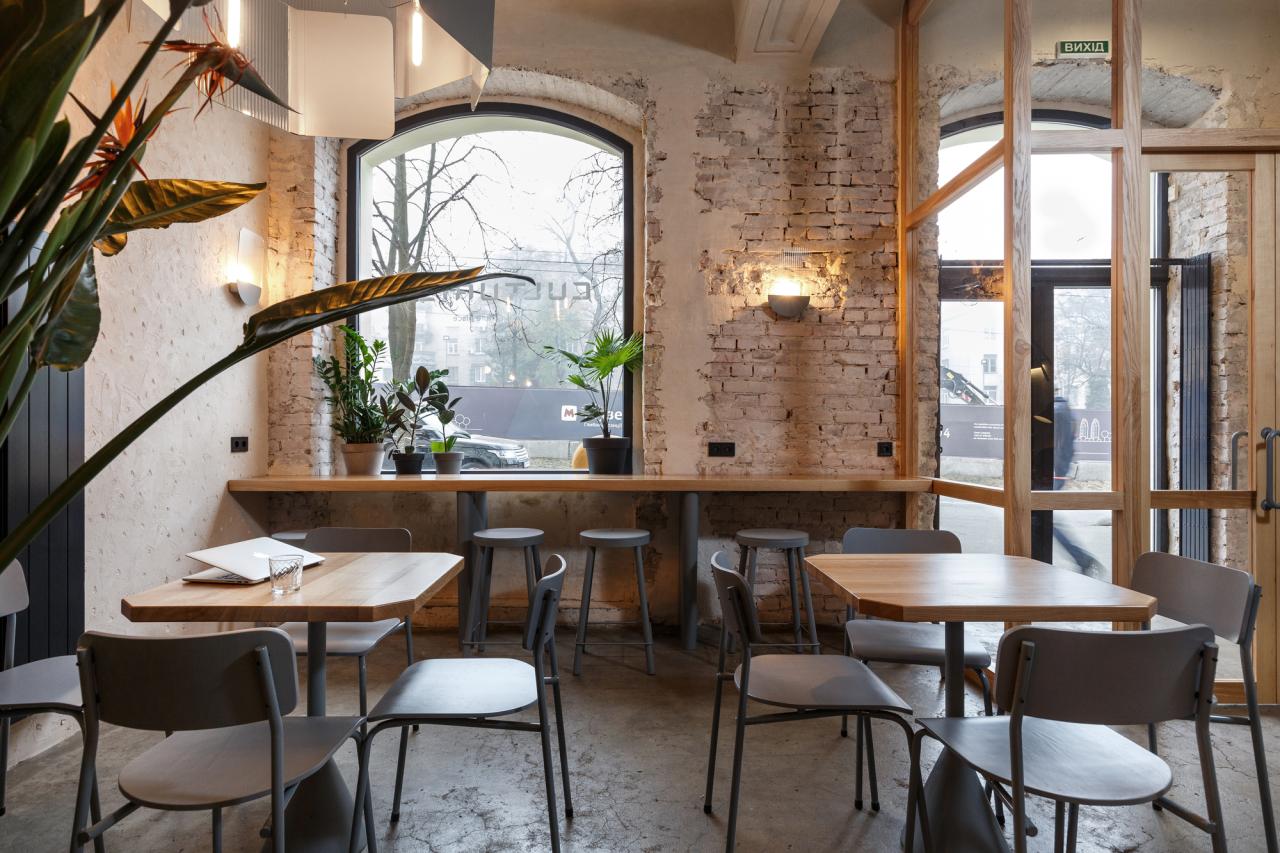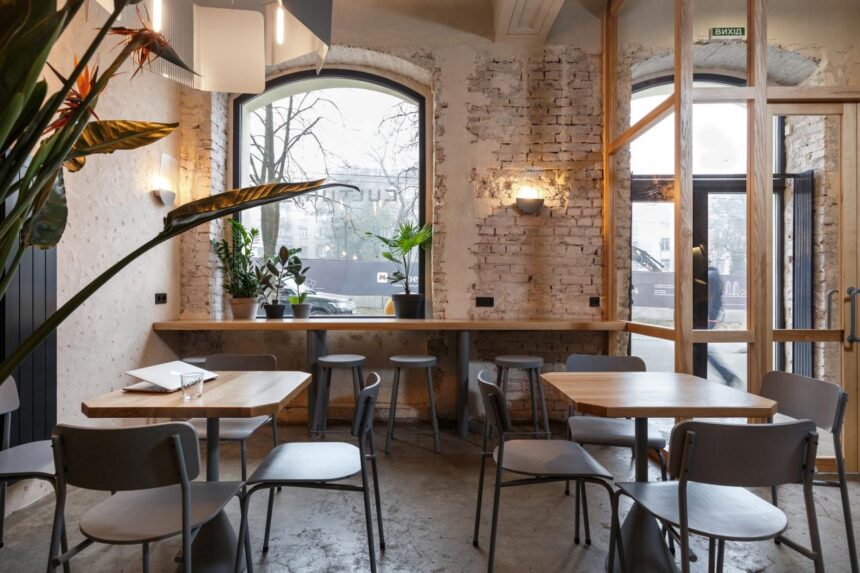Coffee house interior design pictures offer a glimpse into the captivating world of spaces designed to inspire and invigorate. From the warm embrace of a cozy café to the sleek modernity of a contemporary coffee shop, these pictures showcase the artistry of creating environments that seamlessly blend functionality with aesthetic appeal.
These designs go beyond simply providing a place to enjoy a cup of coffee. They carefully consider the elements that create a welcoming atmosphere, from the choice of furniture and color palettes to the strategic placement of lighting and decor.
Each detail contributes to the overall ambiance, influencing the customer experience and leaving a lasting impression.
Furniture and Seating

The furniture and seating arrangements in a coffee house play a crucial role in creating a welcoming and comfortable atmosphere for customers. Well-chosen furniture can influence customer experience, encourage lingering, and foster a sense of community.
Coffee house interior design pictures often showcase unique architectural elements that add character and charm to the space. One popular element is the use of arches, which can create a sense of grandeur and intimacy. You can find inspiration for using arches in your own home by checking out this website for arch design for house interior.
Whether you’re looking for a classic or modern approach, incorporating arches can be a beautiful way to enhance the ambiance of your coffee house or home.
Types of Seating
Different seating options cater to diverse customer needs and preferences. Coffee houses typically offer a variety of seating arrangements to accommodate individuals, groups, and work-from-home patrons.
- Armchairs:Comfortable armchairs provide a cozy and intimate setting for individuals seeking a quiet space to relax and enjoy their coffee. They often feature plush upholstery and supportive armrests, promoting a sense of comfort and relaxation.
- Sofas:Sofas offer spacious seating for groups of friends or families. They are ideal for extended conversations and social gatherings. Sofas with deep cushions and ample back support contribute to a comfortable and inviting experience.
- Bar Stools:Bar stools provide a more casual and informal seating option, often placed at counters or high tables. They are suitable for quick coffee breaks or casual meetings. Bar stools with comfortable padding and footrests ensure a pleasant seating experience.
- Communal Tables:Communal tables encourage interaction and a sense of community. They are typically large and long, accommodating multiple individuals. Communal tables can foster a sense of shared space and facilitate conversations between strangers.
Furniture Choices Influence Customer Experience
The choice of furniture can significantly impact customer experience and flow.
- Comfort:Comfortable seating is paramount in a coffee house, as customers often spend considerable time enjoying their beverages and socializing. Well-padded chairs and sofas, with supportive backrests and armrests, promote relaxation and encourage lingering.
- Space:Adequate space between seating arrangements allows for comfortable movement and prevents overcrowding. It creates a sense of privacy and allows customers to enjoy their coffee without feeling cramped.
- Flow:Furniture placement should facilitate smooth customer flow. Avoid placing furniture in areas that obstruct walkways or create bottlenecks. Strategic placement can encourage customers to explore different areas of the coffee house and discover hidden seating nooks.
Layout and Flow

A well-designed coffee shop layout is crucial for both customer experience and operational efficiency. It should guide customer movement, facilitate service, and create a welcoming atmosphere.The layout of a coffee shop plays a significant role in influencing customer behavior and the overall efficiency of the establishment.
It determines how customers navigate the space, interact with staff, and enjoy their coffee experience.
Open Plan Layout
An open plan layout is characterized by a single, large space with minimal partitions. This layout promotes a sense of openness and accessibility, allowing customers to easily move around and view the entire space. It is well-suited for smaller coffee shops where a more intimate and social atmosphere is desired.
Segmented Layout
A segmented layout divides the space into distinct areas, each with a specific purpose. This layout can be used to create different zones for seating, ordering, and waiting. It can also be used to highlight specific features, such as a pastry display or a coffee bar.
This layout is suitable for larger coffee shops that need to accommodate different customer needs and activities.
Counter-Centric Layout
A counter-centric layout focuses on the service counter as the central point of the space. This layout is common in cafes and coffee shops where the focus is on quick service and takeaway orders. It allows for efficient customer flow and minimizes wait times.
A well-designed layout can enhance customer satisfaction by creating a comfortable and inviting environment.
Sustainable Design

Creating a sustainable coffee house interior is not just a trend; it’s a responsible approach that benefits both the environment and your business. By incorporating eco-friendly materials and practices, you can minimize your environmental impact and create a space that resonates with environmentally conscious customers.
Coffee house interior design pictures often showcase cozy and inviting spaces, with warm lighting and comfortable seating. The design often incorporates elements of rustic charm, like exposed brick or reclaimed wood, creating a welcoming ambiance. For a similar feel in your home, you might consider incorporating elements of cape house interior design , which often features light-filled rooms with traditional details and a focus on natural materials.
Whether you’re designing a coffee shop or your own home, incorporating these elements can create a space that feels both comfortable and stylish.
Sustainable Materials and Practices, Coffee house interior design pictures
Sustainable materials and practices play a crucial role in building a coffee house that is environmentally responsible. Here are some examples:
- Recycled Furniture:Opting for furniture made from recycled materials like reclaimed wood or plastic reduces waste and gives a unique character to your space. A vintage-style coffee table crafted from reclaimed wood can add a rustic charm, while chairs made from recycled plastic offer durability and sustainability.
- Energy-Efficient Lighting:Installing LED lights can significantly reduce energy consumption, leading to lower electricity bills and a smaller carbon footprint. LED lights are known for their longevity and energy efficiency, offering a cost-effective and sustainable lighting solution.
- Water-Saving Fixtures:Implementing water-saving fixtures like low-flow faucets and toilets can conserve precious water resources. These fixtures can significantly reduce water usage without compromising functionality, making them a practical and sustainable choice for any coffee house.
- Locally Sourced Materials:Prioritizing materials sourced locally minimizes transportation distances and reduces the associated carbon emissions. Using locally sourced wood for furniture or flooring not only supports local businesses but also minimizes the environmental impact of transportation.
- Sustainable Flooring:Bamboo flooring is a sustainable alternative to traditional hardwood flooring. Bamboo is a rapidly renewable resource that requires less water and pesticides to grow, making it a more eco-friendly choice.
- Natural Paint:Using natural paints made from plant-based ingredients instead of synthetic paints reduces the release of harmful volatile organic compounds (VOCs) into the air. Natural paints offer a healthier indoor environment and a more sustainable option for your coffee house.
Benefits of Sustainable Design
The benefits of sustainable design extend beyond environmental protection. Here are some key advantages:
- Enhanced Brand Image:A commitment to sustainability enhances your brand image and attracts environmentally conscious customers who appreciate your efforts to minimize your impact. A coffee house with a focus on sustainable practices can appeal to a growing segment of consumers who value eco-friendly businesses.
- Cost Savings:Sustainable practices, such as energy-efficient lighting and water-saving fixtures, can lead to significant cost savings in the long run. Reduced energy consumption and water usage can translate into lower utility bills, making sustainable design a financially sound investment.
- Improved Indoor Air Quality:Sustainable materials and practices can contribute to improved indoor air quality. Using natural paints and avoiding synthetic materials that release harmful VOCs can create a healthier and more comfortable environment for both staff and customers.
- Increased Customer Loyalty:Customers are increasingly drawn to businesses that prioritize sustainability. By incorporating sustainable design principles, you can build customer loyalty and attract a dedicated following of environmentally conscious individuals.
Branding and Identity: Coffee House Interior Design Pictures
A coffee house’s interior design plays a crucial role in shaping its brand identity and creating a cohesive experience for customers. It’s not just about aesthetics; it’s about communicating the brand’s values, personality, and target audience through carefully chosen design elements.
Coffee house interior design pictures often showcase cozy, inviting spaces, often with a mix of rustic and modern elements. The use of warm lighting and comfortable seating creates a welcoming atmosphere. For inspiration on creating a similar feel in your own home, you might find the ideas in 2 storey small house interior design helpful.
These designs often incorporate similar elements like open floor plans and natural light to create a sense of spaciousness and warmth, just like a cozy coffee house.
Examples of Coffee Houses that Successfully Integrate Branding into Interior Design
Successful coffee houses often integrate their branding into their interior design in a way that enhances the customer experience. For example, Starbucks, known for its global reach and consistent brand experience, utilizes a warm, inviting color palette, comfortable seating, and a signature logo that is prominently displayed throughout its stores.
The brand’s focus on convenience and accessibility is reflected in its open floor plan and easy-to-navigate layout.
“A brand is not what you say it is, it’s what people say it is.”
Marty Neumeier
Starbucks’ branding strategy is based on creating a sense of community and belonging, a strategy that is reinforced through its interior design. The use of natural materials, such as wood and leather, creates a welcoming and comfortable atmosphere. The layout encourages interaction, with ample seating for groups and individuals.Another example is the popular independent coffee house, Blue Bottle Coffee.
Known for its minimalist aesthetic and focus on high-quality coffee, Blue Bottle’s interior design reflects these values. The stores are typically clean, bright, and spacious, with a focus on showcasing the coffee-making process. The use of exposed brick, concrete, and natural light creates a modern and industrial feel, consistent with the brand’s emphasis on quality and simplicity.
Conclusive Thoughts
Exploring coffee house interior design pictures unveils a treasure trove of creative inspiration. Whether you’re a coffee enthusiast, an aspiring designer, or simply seeking a dose of visual delight, these images offer a captivating journey through the world of coffee shop aesthetics.
The meticulous attention to detail, the thoughtful use of space, and the seamless integration of function and form all contribute to the captivating allure of these spaces, leaving a lasting impression on visitors and inspiring a sense of wonder and delight.
Expert Answers
What are some common color palettes used in coffee house interiors?
Coffee houses often employ warm and inviting color palettes, such as earthy tones, natural browns, and soft creams. These colors create a sense of comfort and relaxation, encouraging customers to linger and enjoy their coffee.
How does lighting play a role in coffee house design?
Lighting is crucial for setting the mood and highlighting design elements. Ambient lighting provides overall illumination, while task lighting focuses on specific areas like tables and counters. Accent lighting can be used to draw attention to artwork, plants, or other decorative features.
What are some sustainable design principles used in coffee houses?
Sustainable design practices in coffee houses include using recycled furniture, energy-efficient lighting, water-saving fixtures, and locally sourced materials. These principles contribute to environmental conservation and demonstrate a commitment to responsible practices.
